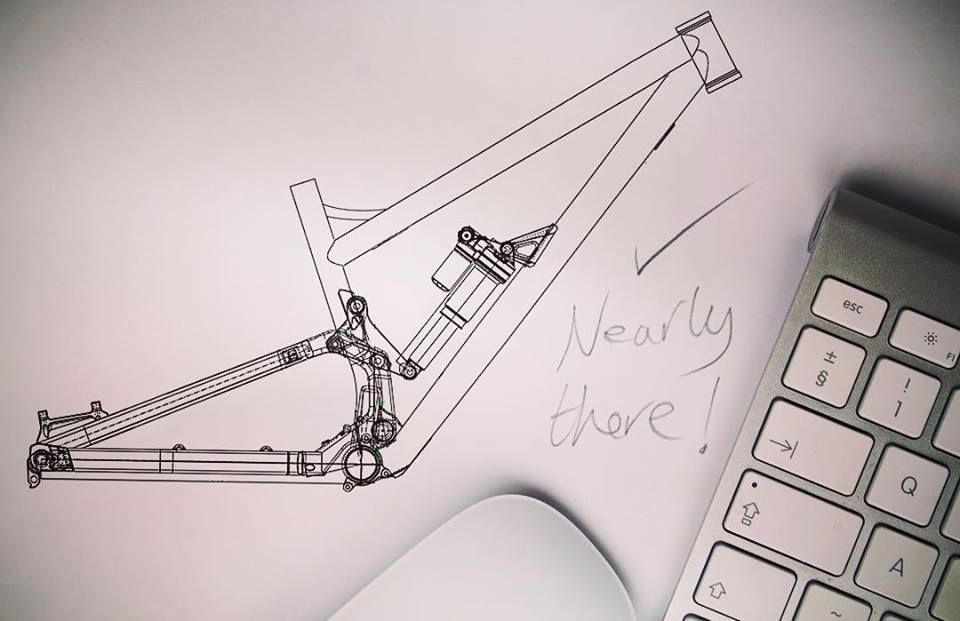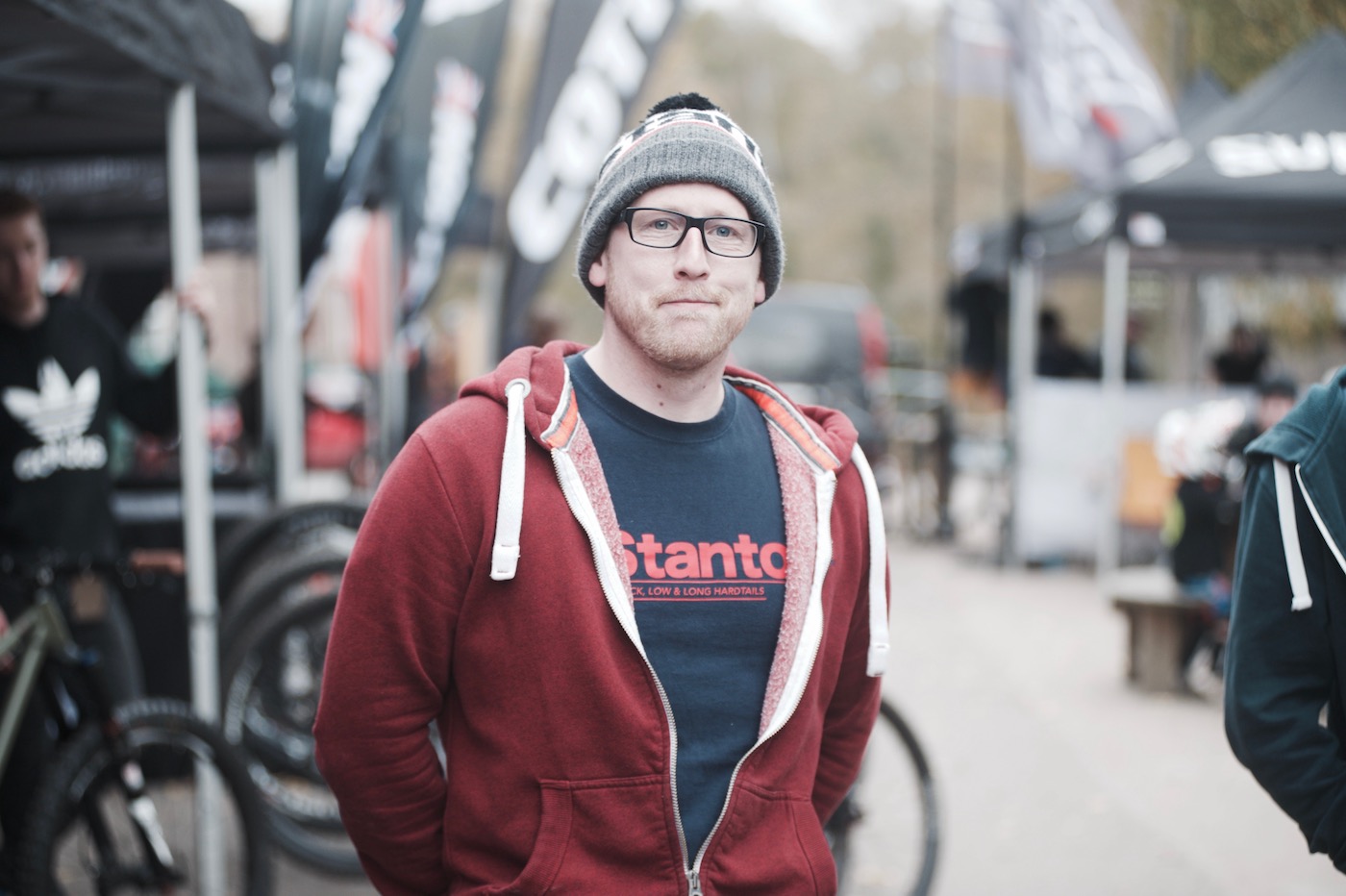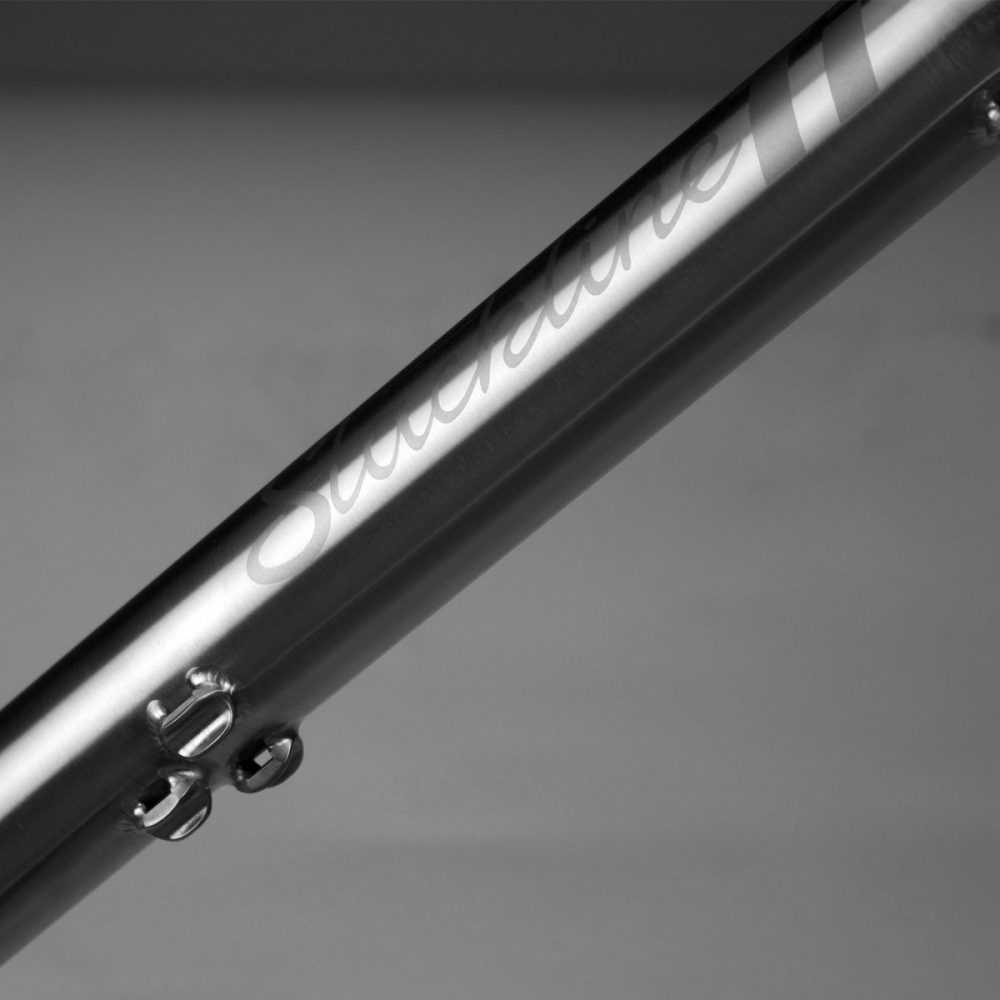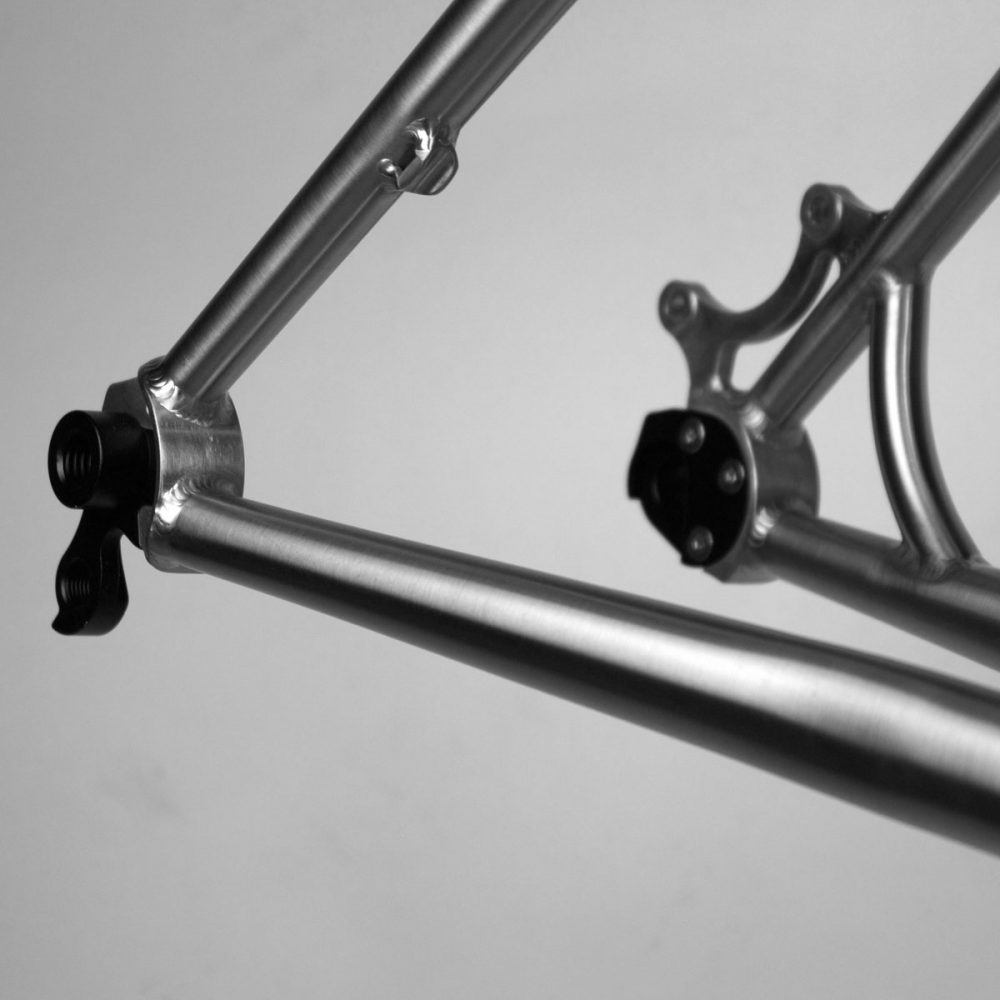Steel is Real Builder’s Interviews #2
Dan Stanton of Stanton Bikes
Interiew by Jamie Edwards / photos by Callum Philpott and Stanton Bikes
The Steel is Real Demo Day was a rare chance to meet some of the guys that are crafting beautiful mountain bikes by hand from steel and titanium.
Our second interviewee isn’t a frame builder himself but is the founder, designer and driving force behind Stanton Bikes.
Dan Stanton started his company as a spare bedroom business, totally self taught and on his and a mate’s steam alongside their day jobs. A few years later, Stanton is now one of the most well known names in the hardtail game, employs a team of full time staff and has a full range of beautiful, tough, fast steel hardtails … with a full suspension bike on the way.
Ladies and gents, Dan of Stanton bikes…


First up, who are you and where are you from?
I’m Dan Stanton from Stanton Bikes, based in Matlock, Derbyshire
Up North
Up North, yeah!
Tell us about Stanton
It’s a bicycle company focussing on producing the best quality products that we can, basically. Really regardless of manufacturing cost.
We’re always looking for not just quality engineering solutions but trying to encourage beautiful aesthetics as well.
Tell me in a bit more detail about your bikes
We make the Slackline, Switchback, Sherpa. We do them in fine grade British steels and also in triple butted aerospace grade titanium.
All yokes are CNC and the aim is to keep the clearances good and the chainstays short, the bottom brackets deep and head angles quite slack regardless of model …but then orientate each model around wheel size.

Where and how did you learn to design and build bikes?
Just by riding shitloads of bikes and then thinking I could do this and then designing the first one and then that was the background, the base structure which gave me parameters to work to and then it was just learning what increments were needed thereafter.
What were you doing before Stanton and what’s got you to this stage?
I did a degree in social and cultural theory. I was going to do a doctorate and I was going to become a lecturer and that was kind of the academic path that I was following.
Then my wife was irritated with the fact that I was just analysing my existence all the time and analysing my relationships with people all the time and always talking about the abstractions of modern society and how disjointed we are from what we are as real beings, and she said to me ‘well why don’t you do what you really want to do?’
I said I wanted to own a bike company and she said ‘well, set about doing it’. So I walked into a bike shop, got a job there, learnt how the industry worked from behind a desk at a bike shop, and once I was there I spent time figuring out how to use CAD, and then designed a bike.
I got my first one made, it rode relatively well but wasn’t right and then that gave me the background to learn what small incremental changes to make to geometry and so on and so forth and here we are now with a bunch of models.
Alright then … As a would-be philosopher on life, and a studier of people, why are bikes so important to the world and to people?
I think happiness is important to people – I know it sounds really corny but really what I’m trying to do here is provide a service, that is to try and make people as happy as possible.
I’ve always liked bikes, I enjoy riding bikes, I love the thrill, I love the adrenaline rush.
I love the different positive chemicals that rush through your body from riding and I guess my aim is to make products that people feel an affiliation to and want to get on and encourage those enjoyments in them too.
What have you had to sacrifice to get to where you are now?
If i’m honest, I had to give up on my fitness for a while. I used to be super fit. When I was in the army I could run a mile and a half in 7 minutes 15 seconds. I was a proper rapid lad and I was always at the front and was good at any sport I put my hand to.
Not to sound a big head, but I just had that real strong base fitness and the last 6 years I’ve spent behind my Macbook trying to drive this business forward and get it to the size that it is, so my riding was sacrificed for a while.
I put weight on and now I’ve got the business to a strong enough place where I’ve got people working for me and I’ve got some more free time and I can invest some more time into my children and invest more time into my personal fitness.
So I go to the gym every morning at 7 o’clock in the morning, henching out like a motherfucker!
<laughing> you’re basically that MMA guy, right?
That’s exactly what I’m going for – Conor Mcgregor yeah.

“It’s everything. I’m putting in everything.
You’ve only got one shot”
How make or break is Stanton for you?
It pays me better than I’ve ever been paid in my life. It’s everything. I’m putting in everything. You’ve only got one shot – don’t miss your chance to blow. Yeah? This opportunity comes once in a lifetime.
<laughing>
Who’s that?
That’s EMINEM
That is EMINEM, yeah. I truly believe that. I believe you get a solid shot and you gotta really throw everything you’ve got into making that one thing really flourish and work.
And my intention is to get Stanton to a size where I can give it to my sons and they’ve got a solid secure future. And if they want to sell it that’s up to them, drive into their own passion that’s fine.
So it can be Stanton and sons. Stanton, Stanton, Stanton and Stanton (Dan has three sons)
D: That’s it. The Quad Stanton.

“Literally everything is done to the highest possible standard because we want to produce the very best”
So how and where are your bikes made?
They’re currently made in one of the very best fabrication firms in Taiwan.
They’re TIG welded, they’re made from triple butted DZB Reynolds tubing. That’s all manufactured in Birmingham and then we export that out to Taiwan and then all of the yolks and everything are CNC’d from one block of either steel or titanium so there’s no impurities in them.
Literally everything is done to the highest possible standard because we want to produce the very best.
Do you know who makes the bikes?
I’ve met them – it’s not a factory in terms of one person welds this and it’s passed on to the next person who welds this.
The last batch I had when I went out to Taiwan, the welder he came over and stopped what I was doing and he shook my hand and he asked ‘Oh you like your frames?’ and I said ‘yeah they’re brilliant’ because he did the whole batch so they set one person on a batch or frames, one person does that whole batch all the way through the process.
Why steel over any other material? Why is steel important to you?
Well, I’m gonna be marginally controversial.
I don’t think you should just be using steel because it’s steel and you should be using it everywhere. I think that specific materials have specific properties and they lend themselves to specific types of riding and specific types of bikes.
“I don’t think you should just be using steel because it’s steel”
So hardtails I think, yeah, they should be steel or titanium. Titanium is dead expensive so there’s only a small amount of the market that will actually go for titanium, but it’s the best material for a hardtail regardless of what anybody else says. It quite evidently is. It’s tougher, it has higher elasticity. When you’re manufacturing in it you’re putting material into it, you’re increasing diameters so it’s like plasticine, you can be far more playful with the material to get it to feel exactly how you want it to feel.
On steel frames, the wall thicknesses have to be far greater than what they used to be to pass testing. But you’re still trying to take material out of steel frames. You’re trying to get tubing as thin as you can. Still trying to reduce you diameters to encourage flex within the tolerance, within the fine line of testing.
You could make a Ti frame with the same tubing wall thickness as steel but it would be really, really bandy. So with steel, you’re trying to put meat into and you’re adding weight. But as you do you’re just making it stronger and stronger.
Personally I think full suspension should be alloy or carbon. Carbon is much stiffer with minimal weight penalty. We’re staying with steel for design ascetics and designing out the flex with the aluminium CNC linkages and swing arm parts.

So your full suspension bike is going to be made out of all sorts of materials?
Alloy and Steel. We’ll have an aluminium rear end and steel front.
There’s two small CNC’d parts to make sure the alignment’s going to be bang on because obviously we don’t want any difficulty with that. But then the pieces of the swing arm that meet the linkage parts, they’re CNC’d aluminium rather than tubular, so that encourages a lot more stiffness.

A lot of people are trying to make bigger and longer bikes but your geometry has always been a bit more restrained. Why is that?
I was the first designer to do a 64d static super slack 650b bike with super short chain stays and a deep bottom bracket. That was the original Switchback and no one else was doing shit like that. And it was considered pretty long really when it first came out.
I feel now though that I’ve hit what I perceive as the correct number.
People are just making reach longer and longer for fashion. On a hardtail I don’t think that’s correct at all. On a hardtail it’s all pivoting around the rear axle and the contact patch of the tyre. So your reach measurement is variable and increases in length as the bike dives through its travel. The head angle steepens up as its going through its travel and the reach gets longer and longer and the stack gets shorter and shorter.
“People are just making reach longer and longer for fashion.
On a hardtail I don’t think that’s correct at all …when things get techy, you’re in the shit”
If you’re coming into a rock garden with a 450mm reach with a 140mm fork, by the time you slam towards the bottom of that fork when you’re at the most vulnerable position on the bike in the most techy, difficult situation your reach has all of a sudden pulled you another 50mm forward. So then you’re struggling to get your ass over the back wheel.
But I do believe reach is a valuable measurement and I think on a full suspension, longer reach is good. It actually reacts differently on a full suspension, as you come rumbling into a rock garden you push your feet down and lean your weight back and your suspension unit swallows up 50mm which reduces your reach by 30/40mm. The bike reacts totally differently.
It seems at the minute that people have taken that technology of longer reach from full suspension and they’re just trying to implement it onto hardtails. It’s not very logical as far as I’m concerned. If you put the information into a CAD programme you’ll see that when things get techy, you’re in the shit.
As much as you can, describe the feel of your bikes to someone that hasn’t ridden one.
I’d say they’re really playful, super stable, agile and just comfortable. Comfortable is a massive one and that’s why we use the steels we use, because we can to 0.5mm wall thickness with Reynolds 853 and 631DZB triple butted tubing.
Rather than just using standard 4130 we’re able to get down to 0.5mm wall thicknesses so we’re not having to over engineer it to pass CEN testing. Instead we can make light, comfortable, flexible frames.

What do you think are the most important things to consider when you’re designing a bike?
Obviously ride quality, in terms of comfort.
Then the aesthetic is obviously important, because people want an attractive product. So trying to find attractive engineering solutions not just big bits of flat plate to get clearances.
Also the industry’s sways and movements like Boost and Plus tyres and chain ring sizes and all the different necessities and fitments – you want to make it so your frame can do as many of them as possible so that it makes it simple for the customer and they feel like they’re getting a better value product because they’ve got more flexibility and choice.
Last question then. What’s next for Stanton? What does the future hold?
Big question this one.
We’ve just smashed a wall down upstairs in the unit and we’ve taken the unit next door. In January we’ll have a full powder coating and painting facility in house. By April I intend to have the first production model full suspension bike all made in house at Stanton Bikes.
We’ll have the prototypes finished by the end of this year but they’ll be welded by Pat at Limit Fabrications and once we’ve got those we can start showing exactly what we’re going to be making in house.
Then it’s a case of advertising for the welder and we get him to come on board and we’re away.
So if someone wants a job as a welder?
Literally, we’re looking to take on a full time welder. We’re going to be paying handsomely!
I’m not just looking to rinse the shit out of everyone that works for me and make bare hench money and buy yachts and shit like that.
What I’m looking to do is create a lifestyle that I’m happy with that I want to live with and make our own little abstraction from standard capitalism so that we all have a flexible working environment, we all know how much work we’re going to do through the year, we break that down per week and then you can ask “do you have time go riding during your working hours?”.
All that matters is that the work that we’ve agreed is completed. And that’s it. We want to run it like that, like a family.
The Hardtail Hooner – Stanton Bikes from Tom Caldwell on Vimeo.
Any closing words of wisdom?
Those who own the means of production, also own the means of logical thought. Karl Marx. There you go!
<laughing> There you go, thanks!
Thanks!
Thanks to Dan for taking the time away from his mad busy demo day to grab a coffee and chat with us.
You can learn more about Stanton bikes over on their website.









